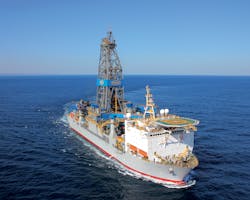Operators continue to find new oil reserves in deepwater Gulf, despite scaled-back drilling campaigns
In this post-downturn era, offshore operators and developers continue to be cautious with their drilling programs in the US Gulf of Mexico. A working rig count in the low-to-mid 20s – a 60% decline since January 2014 – seems to be the new norm.
Nevertheless, Gulf operators have pressed forward with their slimmed-down exploration plans. These activities did bring a number of notable discoveries over the past year, most notably in the Miocene and Paleogene plays, in the deepwater Gulf.
In April, Shell announced that it had made an oil discovery at the Blacktip prospect in the deepwater Gulf. Located in Alaminos Canyon block 380 in about 6,200 ft (1,890 m) of water, Blacktip is a Wilcox discovery in the Perdido thrust belt, about 30 mi (48 km) from the Perdido platform and Whale discovery.
The Blacktip exploration well encountered more than 400 ft (122 m) net oil pay with good reservoir and fluid characteristics. Evaluation is ongoing and appraisal planning is under way to further delineate the discovery and define development options, Shell said.
Blacktip is operated by Shell (52.375%) and co-owned by Chevron U.S.A. Inc. (20%), Equinor Gulf of Mexico LLC (19.125%), and Repsol E&P USA Inc. (8.5%). Shell says that Blacktip adds to its Paleogene exploration success in the Perdido area.
In June, W&T Offshore reported that it had discovered oil at the Gladden Deep prospect in Mississippi Canyon block 800 in the deepwater Gulf. The Gladden Deep well is in about 3,000 ft (914 m) of water and was drilled to a total measured depth of 18,324 ft (5,558 m). It encountered 201 ft (61.3 m) of net oil pay.
W&T operated the well which is one of the 14 wells planned for the drilling program under the Monza JV. The company owns a 17.25% interest in the discovery.
Based on preliminary analysis of drilling and wireline logging results the recoverable resource is expected to be in line with the pre-drill estimate of 7 MMboe gross, according to partner Kosmos Energy (20% working interest). Gladden Deep is being developed as a subsea tieback and was expected to be brought online through the existing Gladden pipeline to the Medusa spar in 4Q 2019.
In August, Talos Energy announced that it had hit oil pay at the Bulleit and Orlov prospects in the deepwater Gulf. At the Bulleit prospect in Green Canyon block 21, the well encountered about 140 ft (43 m) of net true vertical depth (TVD) oil pay in the shallow target, the DTR-10 Sand, and about 110 ft (34 m) of net TVD oil pay in the deeper MP Sand.
The company said it experienced delays and additional costs during drilling due to difficult hole conditions below the DTR-10 Sand that necessitated a side track of the original well path to a new directional plan.
The well will be completed in the first half of 2020 and then tied back to the Talos-owned and operated Green Canyon 18 fixed platform located about 10 mi (16 km) west of Bulleit.
The Bulleit prospect, originally generated by EnVen Energy, is now 50% owned and operated by Talos, with EnVen and Otto Energy owning 33.3% and 16.7%, respectively.
At the Orlov prospect in Green Canyon block 200, the well initially encountered about 100 ft (30 m) of net true vertical thickness oil pay in the main target Aspen J sand, as well as additional pay sands in shallower zones along the same trap. Operator Fieldwood Energy has a rig on location and was expected to re-enter the well and drill an appraisal side track to optimize the well location in relation to the discovered resources.
Initial production from Orlov is expected in 1Q 2020 and will be tied back to the Fieldwood-operated Bullwinkle fixed platform. Talos owns a 30% working interest.
In October, Hess Corp. announced that it had made an oil discovery at the Esox-1 exploration well on Mississippi Canyon block 726 in the deepwater Gulf. Esox-1 was drilled in 4,609 ft (1,405 m) of water and encountered about 191 net ft (58 m) of high-quality oil-bearing Miocene reservoirs. Esox-1 is about 6 mi (10 km) east of the Tubular Bells production facilities.
CEO John Hess said: “We expect the well to be producing in the first quarter of 2020. As a low-cost tieback to existing infrastructure, Esox should generate strong financial returns.” Hess is the operator and holds 57.14% interest in Esox; and Chevron U.S.A. Inc. holds 42.86% interest. •
For more on deepwater discoveries made in the Gulf of Mexico, turn to Offshore’s annual survey, Status of US Gulf of Mexico Deepwater Discoveries.
About the Author
Bruce Beaubouef
Managing Editor
Bruce Beaubouef is Managing Editor for Offshore magazine. In that capacity, he plans and oversees content for the magazine; writes features on technologies and trends for the magazine; writes news updates for the website; creates and moderates topical webinars; and creates videos that focus on offshore oil and gas and renewable energies. Beaubouef has been in the oil and gas trade media for 25 years, starting out as Editor of Hart’s Pipeline Digest in 1998. From there, he went on to serve as Associate Editor for Pipe Line and Gas Industry for Gulf Publishing for four years before rejoining Hart Publications as Editor of PipeLine and Gas Technology in 2003. He joined Offshore magazine as Managing Editor in 2010, at that time owned by PennWell Corp. Beaubouef earned his Ph.D. at the University of Houston in 1997, and his dissertation was published in book form by Texas A&M University Press in September 2007 as The Strategic Petroleum Reserve: U.S. Energy Security and Oil Politics, 1975-2005.

